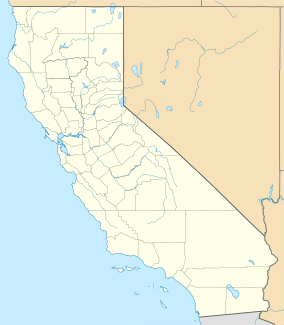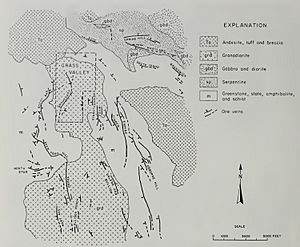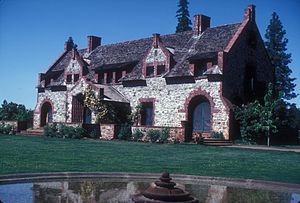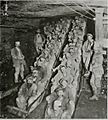Empire Mine State Historic Park facts for kids
Quick facts for kids Empire Mine State Historic Park |
|
|---|---|
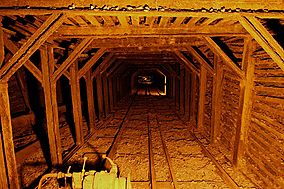
View along the main drift at Empire Mine
|
|
| Location | Nevada County, California, United States |
| Nearest city | Grass Valley, California |
| Area | 853 acres (345 ha) |
| Established | 1975 |
| Governing body | California Department of Parks and Recreation |
|
Empire Mine
|
|
| Area | 777 acres |
| Built | 1896 |
| Architect | Polk, Willis |
| NRHP reference No. | 77000318 |
| Added to NRHP | December 09, 1977 |
The Empire Mine State Historic Park is a special park and an old gold mine in the Sierra Nevada mountains. It's located in Grass Valley, California, USA. This mine is very important! It's listed on the National Register of Historic Places and is a California Historical Landmark.
Since 1975, California State Parks has taken care of the Empire Mine. It's known as "one of the oldest, largest, deepest, longest, and richest gold mines in California." From 1850 until it closed in 1956, the Empire Mine produced a huge amount of gold. Miners dug out 5.8 million ounces (that's 165 tons!) of gold. They did this from underground tunnels that stretched for 367 miles (591 km) – that's longer than some states!
Contents
The Mine's Exciting History
Discovering Gold and Early Days
In October 1850, a man named George Roberts found gold in a rock on Ophir Hill. He sold his claim in 1851. Soon, a company called Woodbury, Parks and Co. bought up several local claims. They named their mine the Ophir Hill Mine.
However, they had money troubles and had to sell the mine in 1852. John P. Rush and the Empire Quartz Hill Co. bought it. In 1854, the Empire Mining Co. was officially started.
Cornish Miners and New Technology
When people heard about the gold in California, skilled miners came from Cornwall, England. They brought their knowledge of hard rock mining. A key invention they brought was the Cornish engine. This steam-powered machine pumped out 18,000 US gal (68,000 L; 15,000 imp gal) of water from the mine every day. This helped miners dig deeper and find more gold.
Later, in 1895, Lester Allan Pelton's water wheel provided electric power for the mine. The Cornish miners continued to be the main workforce for about 80 years.
Bourn Family Takes Over
William Bowers Bourn took control of the company in 1869. After he passed away in 1874, his son, William Bowers Bourn II, took charge. In 1878, he started the Original Empire Co. and continued to expand the mine.
With his money and the mining skills of his cousin, George W. Starr, the Empire Mine became famous for its advanced mining technology. Bourn even bought another big mine, the North Star Mine and Powerhouse, in 1884.
The Beautiful Bourn Cottage
William Bourn re-bought the Empire Mine in 1896. In 1897, he asked an architect named Willis Polk to design a special house. This house, called the "Cottage," was built using waste rock from the mine! It had lovely gardens, fountains, and a reflecting pool. Later, a clubhouse with tennis courts, a bowling alley, and squash courts was built nearby.
New Ways to Get Gold
In 1910, the Empire Mine started using a new method called a cyanide plant. This made it easier to get gold from the ore. Bourn also bought neighboring mines in 1915. This gave the Empire Mine access to even more gold veins.
Empire-Star Mines and Closure
In 1928, Newmont Mining Corp. bought the Empire Mine from Bourn. They also bought the North Star Mine, combining them into Empire-Star Mines, Ltd.
During World War II, the US government decided that gold mines were not "essential" for the war effort. So, the mine had to close from 1942 to 1945. After the war, it was hard to find enough skilled miners. By 1951, they had to stop digging below 4,600 feet.
By the 1950s, the cost of mining gold was too high compared to the price of gold. In 1956, a miners' strike over low wages finally led to the mine's closure. The last pumps were shut down on May 28, 1957. In its final year, the mine had reached a depth of 11,007 ft (3,355 m).
Becoming a State Park
In 1974, California State Parks bought the surface land of the Empire Mine. They paid $1.25 million to create this state historic park. Today, the park covers 853 acres (345 ha; 3.45 km2; 1.333 sq mi), including beautiful forested areas. The Newmont Mining company still owns the rights to the minerals, in case they ever decide to reopen the mines.
What's Under the Ground?
The area around the Empire Mine has a large body of rock called Granodiorite. This rock is about five miles (8 km) long and two miles (3.2 km) wide. The gold ore is found in quartz veins within this rock. These veins held a lot of gold, usually 3 to 7 ounces per ton of rock.
The main Empire Vein goes deep into the earth at a 35-degree angle. Miners followed this vein with slanted shafts. They also dug horizontal tunnels, called drifts, every 300–400 ft (90–120 m) to reach the gold.
Exploring the Museum and Gardens
If you visit the park on weekends from May to October, you can see volunteers dressed in old-fashioned clothes. They give tours of the Bourn Cottage, showing what life was like in the 1890s. You can also see demonstrations of how the mine worked.
The park's museum has a cool model that shows all the underground tunnels of the Empire/Star mine. You can also see samples of gold ore and other minerals. There's even a recreated Assay Office, which is where they tested the gold. Don't forget to explore the 13 acres (5.3 ha) of beautiful gardens!
The Sierra Gold Park Foundation helps the park with its educational programs. They get support from donations, sales at the visitor center, and special events. Many volunteers also help make the park a great place to visit.
More to See
- North Star Mine and Powerhouse
- List of California state parks
- California Historical Landmarks in Nevada County
Images for kids


